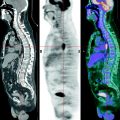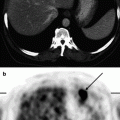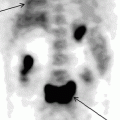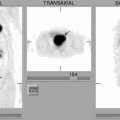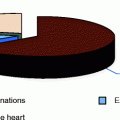, Leonid Tiutin2 and Thomas Schwarz3
(1)
Russian Research Center for Radiology and Surgery, St. Petersburg, Russia
(2)
Department of Radiology and Nuclear Medicine, Russian Research Center for Radiology, St. Petersburg, Russia
(3)
Department of Nuclear Medicine Division of Radiology, Medical University Graz, Graz, Austria
Abstract
Malignant tumors primarily originating from osseous and muscular tissue are a relatively rare disease (0.6% of the total number of oncological diseases). These tumors have a very heterogeneous structure, diverse histological texture and different degrees of malignancy. The frequency of soft tissue (muscle) tumors in epidemiological reports is 2–3 per 100,000 people and that of primary bone tumors is 1 per 100,000. About 780 soft tissue sarcomas of different localizations and 2,600 tumors of bone tissue are reported every year in the USA (Landis et al. 1999).
18.1 Epidemiology
Malignant tumors primarily originating from osseous and muscular tissue are a relatively rare disease (0.6% of the total number of oncological diseases). These tumors have a very heterogeneous structure, diverse histological texture and different degrees of malignancy. The frequency of soft tissue (muscle) tumors in epidemiological reports is 2–3 per 100,000 people and that of primary bone tumors is 1 per 100,000. About 780 soft tissue sarcomas of different localizations and 2,600 tumors of bone tissue are reported every year in the USA (Landis et al. 1999).
Sarcomas of soft tissues or soft tissue tumors (STT) may have any localization, though it is mainly limb muscle bulk that is affected. For some kinds of tumors, age criteria have some importance. For example, rhabdomyosarcoma appears mainly in children, whereas fibrohystiocitoma or lyposarcoma appear at an elderly age. The same distribution characterizes primary bone tumors: osteosarcoma or Ewing’s sarcoma as a rule develops at an adolescent age, contrary to chondeosarcoma which develops at an elderly age.
Most muscle and bone tumors do not have a distinct etiology. However, recently there have been data on special forms, in which typical (for a given form) gene mutations and tumor suppressor genes have been found. For example, RB and p53 are often revealed exactly in presence of sarcomas (Golubovskaya et al. 2008).
Soft tissue sarcomas are malignant tumors which emerge in the mesenchyma. Bone tumors are classified according to the dominant cytosignal: 20% of tumors have the so-called chondral differentiation, in 40% of cases they issue from the hemopoetic system (multiple myeloma), in 18% they primarily originate from bone tissue, and in 4% they are of fibrohistiocytic origin. The histologic differentiation of Ewing’s sarcoma is unknown (hypothetically it may be of mesenchymal origin).
18.1.1 The Degree of Malignancy of Tumors
1.
Highly differentiated
2.
Intermediately differentiated
3.
Lowly differentiated
4.
Non-differentiated
The operative classification of soft tissue tumors and primary bone tumors is given in Table 18.1.
Table 18.1
STT and PBT classification
Description of tumor | Frequency of occurrence (%) | Typical age of manifestation (years) | Primary localization |
|---|---|---|---|
Fibrosarcoma | 10 | 30–50 | Limbs |
Malignant fibrohystiocitoma | 20–30 | 50–70 | Upper limbs, retroperitoneum |
Lyposarcoma | 15–18 | 40–60 | Lower limbs |
Leiomyosarcoma | 7 | 50–60 | Retroperitonially, skin, subcutaneously |
Rhabdomyosarcoma | 14 | 7–11 | Limbs, head, neck |
Angiosarcoma | 1 | 50–70 | Skin, lower limbs |
Synovial sarcoma | 8–10 | 20–30 | Articulations |
Malignant schwannoma | 5–10 | 25–50 | Lower limbs, torso |
Primary neuroectodermal tumor | 1 | 15–35 | Lower limbs |
Extra skeletal Ewing’s sarcoma | 1 | 10–30 | Lower limbs, paravertebrally in the thorax |
Osteosarcoma | 24 | 10–20 | Tubular bones |
Chondrosarcoma | 13 | 30–60 | Torso, limbs |
Malignant large cell sarcoma | 0.5 | 20–40 | Epiphyses |
Fibrosarcoma | 3.3 | 15–60 | The whole body |
Histiocytoma | 1.6 | 10–70 | Tubular bones |
Ewing’s sarcoma | 6.6 | 10–20 | Skeleton |
Primary bone lymphoma | 6.6 | 20–70 | Skeleton |
Plasmocytoma | 40 | 40–70 | Head, backbone, pelvis, upper limbs |
Soft tissue and bone tissues metastasize hematogenously mainly to the lungs and to bone structures.
18.2 Diagnosis
The standard methodology of radiological examination includes roentgenography, CT, MRI, osteoscintigraphy and angiography. For final verification of the diagnosis, histological analysis is usually needed. For this purpose, open biopsy or bone marrow biopsy are done.
Stay updated, free articles. Join our Telegram channel

Full access? Get Clinical Tree


